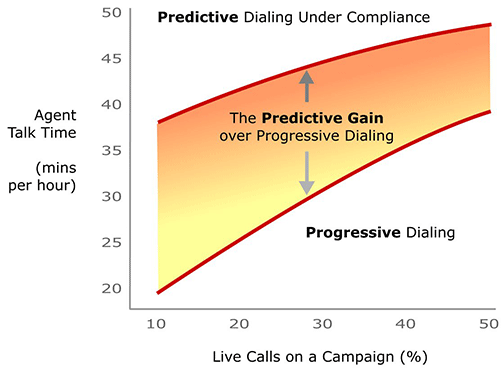1. Introduction and purpose
The world of outbound calls has been in the news a lot in recent years. In particular, fuelled by consumer reaction to the way that their telephones and privacy have been abused, the outbound world has been moving inexorably towards regulation. There is widespread awareness of the development of ‘do not call’ lists, which in any mature outbound market are becoming a civilised ‘must have’. Less discussed is the predictive dialling technology used to automate outbound campaigns, be it telemarketing, market research or other activities.

The predictive gain
This technology has caused considerable consumer abuse in many markets in recent years and, as in the case of ‘do not call’ lists, has now come under regulatory pressure, especially in the more established outbound countries, such as the UK and the US.
This article looks at the challenges that dialler regulation brings. It is aimed at providing an insight into how diallers really work, so users can make more-informed investment decisions. It will also be of interest to third-party dialler users who are concerned about the productivity of their existing equipment.
2. Does compliance work?
The basis for judging whether a predictive dialler is any good is not how much talk time per agent hour it produces under compliance! It is about the quality of dialler performance under compliance. The only way to measure this is to look at the incremental performance that a dialler produces when, dialling under compliant conditions, it moves from progressive to predictive mode.
Take a look in Figure 1 at the kind of ‘predictive gain’ that a dialler produces on a typical telemarketing campaign with 20 agents. With a properly designed dialler, the ‘predictive gain’ can be very high, especially under tough dialling conditions, such as low levels of live calls. A corollary of this is that if a dialler is not designed to cope under the tough new regulations now facing diallers, then the opportunity cost, i.e. the loss in productivity can be equally big.
Imagine this for a moment. Think of a motor car that has been given 50 litres of petrol to get from Point A to Point B, and where someone then comes along, siphons off 47 litres, and tells them to go for it! No prizes for realising that they will have to walk most of the way if they expect to get to B.
Here’s another way of looking at the challenge compliance has brought to diallers. Imagine that you are running a predictive campaign where one in every five calls is answered by a person, and you are working within the FTC limit of 3% for abandoned calls.
What is the maximum number of abandoned calls you can make under compliance per 1,000 calls dialled? This is not a trick question; think about it for a moment, before you check the answer.
The answer is 3% x 20% x 1000 = 6!
The result is completely at odds with how diallers have been designed and thought of historically. Suddenly abandoned calls are not only the sole kind of nuisance call that a dialler can make, but they have also become a very scarce resource. Use up your small quota too quickly and you have to dial in non-predictive mode to remain compliant! So, for a typical dialler, how quickly do you think this number of abandoned calls might be used up in our example of 1,000 calls?
Unless predictive diallers have been designed from the ground up to cope instantly and precisely with any and all changes to campaign conditions and deliver a dialling rate that corresponds to a maximum abandoned call target of 3%, then they are unlikely to get far into the 1,000 calls in our example. They will use up the allowable abandoned calls and then be forced to shut down into progressive dialling mode, i.e. dialling out on just one line, rather than several, for each call. This means that the ‘predictive gain’ on a campaign will fall off sharply, taking talk times per hour down from as much as 45+ minutes to around 30 minutes, or even less.
3. Spotlight on design
Predictive dialler designs are not alike and if you are going to invest big dollars in a predictive dialler, is it not reasonable for you to question how a product really works rather than just subject yourself to a friendly reference site visit? Let’s look at some popular design notions that most dialler users will be familiar with and see what sense we can deduce from them.
(i) Predialling for specific agents
Many diallers ‘watch’ what an agent is doing through talk and wrap activities and try to understand behaviour patterns that can then be used to predict when that agent will be free. This allows the dialler to pre-dial for an agent so that hopefully a live call will be waiting for them as they become free to take another call, or shortly thereafter.
This particular idea has its roots in the 1980s when diallers were developed for the collections marketplace. There were two crucial differences from today:
In those days, it could take up to ten seconds to reach a called party, because of latency and delay issues, and during at least some of this time you could cancel a call before it started ringing, thus not causing a nuisance. And you would do this if the agent(s) suddenly got another live call(s).
If you got your timing wrong and the called party was on the line, but no agent was free, then you simply kept the called party waiting. He owed you money, so this was seen as a reasonable thing to do.
But life has changed! You pulse the digits out to the network and with today’s diallers and networks you are ringing in the called party’s home in round about a second a two. So what if the called party answers the phone quickly? The agent may still be closing a call and yet is being asked to take another one! In today’s regulatory climate you cannot just put the answered call into a hold queue, as diallers used to. The call has to be abandoned and then counts towards the 3% regulatory quota. Under compliant conditions it is simply impossible to track what an agent is doing in any meaningful way and predial specifically for him, without totally compromising predictive performance.
Remarkably, this idea continues to cast its seductive spell.
(ii) The supervisor controls the dialler
The next popular idea that many readers will be familiar with is the notion that supervisors can and should control what diallers do. The dialler industry has spawned a generation of supervisors who sit over the dialler monitoring performance minute by minute, making small adjustments to the pacing algorithm in order to get maximum performance.
What is amazing about this practice is that the big brands in the dialler industry have convinced a whole generation of users that this is the way to manage a dialler. Users have been attracted to the idea because it gives them a sense of control of their destiny. Even today the vast majority of the users of big-brand diallers are convinced that unless they have control over pacing, the dialler can’t be any good!
If you are running a number of campaigns, each involving an array of constantly changing data, for example changes in live call rates, talk times and so on, there is simply no way that the human brain is capable of calculating dialling rates with any precision.
Humans cannot calculate dialling rates with the precision that performance under compliance needs; like the blindfolded driver, they are reactive rather than proactive. This means that if the dialler is trying to achieve reasonable predictive performance, then the quota of abandoned calls available to a campaign gets used up quickly, before the dialler can get properly into predictive stride.
But automation of pacing is no guarantee whatsoever of excellence in performance. It is simply a necessary step on the way. What matters is what gets automated. The easy route is a reactive one, where the dialler monitors hit rates, abandoned call levels and a few other key indicators and changes direction, according to movements in them. This is very much akin to automating the driver we talked about earlier, but still with the blindfold on. We expect most automated solutions to be of this type, but it is at least a step in the right direction.
Contributors
- Michael McKinlay of Sytel
Author: Jonty Pearce
Published On: 12th Apr 2010 - Last modified: 14th Jul 2023
Read more about - Workforce Planning, Dialler, Outbound dialling, Outbound Dialling Guide, Sytel















